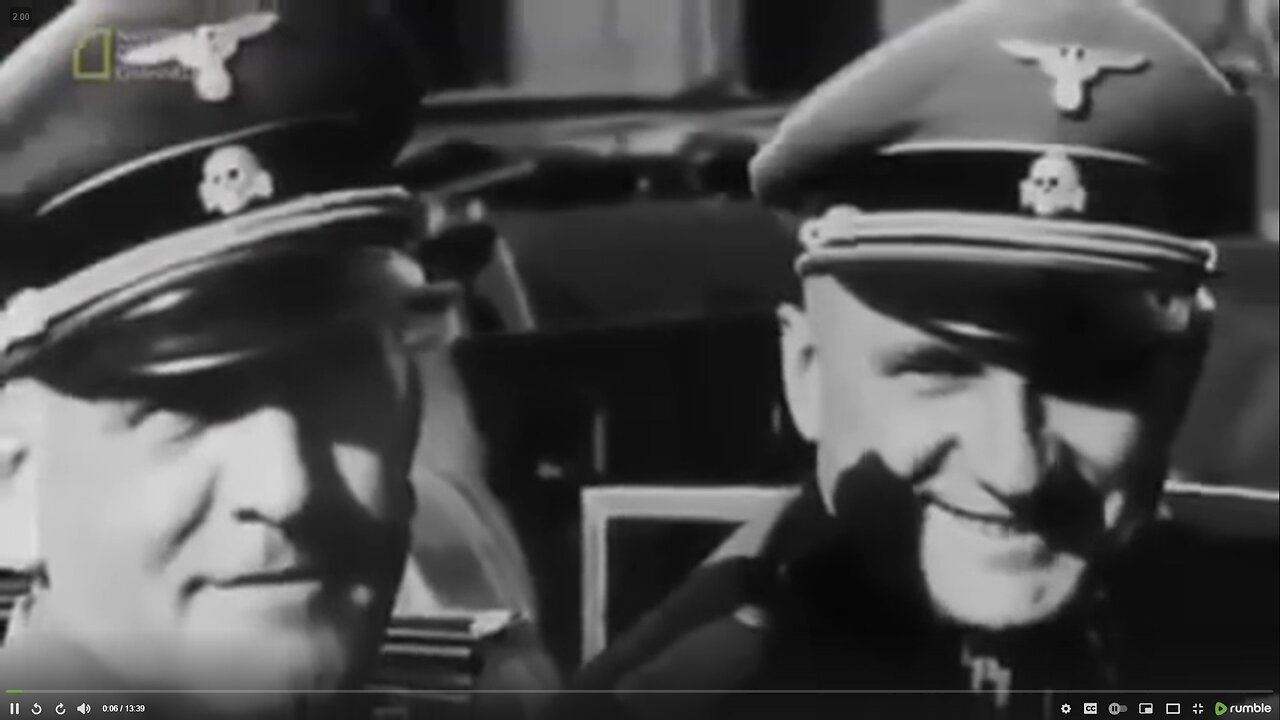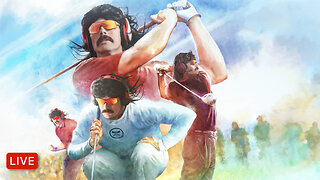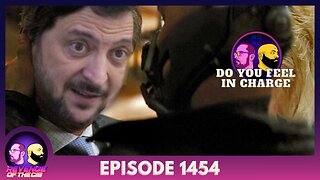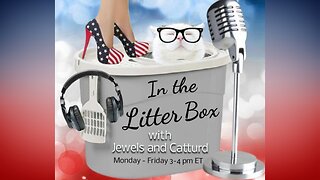Premium Only Content

The Auschwitz Albums: It s demonic that they were not demonic!
https://www.youtube.com/watch?v=6_F9GMeydiA
The Nazis were profoundly tempted, on the one hand, to hide what they were doing, and on the other hand to broadcast it and to say, wow, look at us, look what we've done. And what happened from time to time is that photographs were taken and they give a visual representation of things that I know from documents. I myself have never seen anything quite like this. This is his own sense of his personal experience during the war, what he thought was important, what presumably he wanted to remember, share with his family, what he thought was valuable. So I think this is going to be rich fire for people to speculate on this one individual I don't think we'll ever find anything quite like this again. Here what you see is you see the faces of the killers we're trying to unwind. Boy, we had a tough day at the office. It was hard out there. And these were men who took a certain, and I'm going to use the word deliberately, they took a professional pride in what they were doing. This scrapbook strikes me because I think the big question about the Holocaust is why? You know, why do people kill? Why were so many people able to do this in the heart of such a civilized nation? And it shows the killers as humans. This is a question that I think doesn't have answers, but this scrapbook forces us to look at the killers in a way that I think pushes our comfort level where we don't want it to go. We do know a fair bit about Carl Hooker. He was born in Engershausen, Germany. His father died in World War I, and his mother struggled to raise him and his brothers and sisters. He became a bank clerk in the 1930s and joined the SS, he said in his testimony, to promote his career. There's no evidence that that ever promoted his career. In the Frankfurt trial in 1963, one of the prosecutors intimated that Carl Hooker may have been sent to Auschwitz because he was so good at killing. He was so good at working at a concentration camp that Carl Hooker would be sent to kind of guide the commandant through what it was like to work at a concentration camp. So his testimony hinged on the fact whether or not he had been on the ramp and had participated in a selection process, choosing people to either go to the gas chambers or to be selected to work. And no one could prove, no one could testify that they had actually seen him there. People testified to say that he must have been there, they were sure he had been, everyone else had been, but no one could testify that they had actually seen him there. So he actually only got seven years. And so he was in prison until 1970 and then released. He went back to banking again, he took up gardening, and he died presumably of old age in the year 2000. The death of Hooker in his bed in 2000 violates our sense of justice. We would like to believe that there is a God who meets out justice in this world. It makes us wish there was a world after this world in which justice is meted out to the evil. I think when we first got the album, of course, we were really excited because we knew the possibilities for scholarship, for new information to come forward. And then the more that we learned about it, we became angry. I became angry, some of my colleagues became angry just because you see these guys and you know what's going on and the fact that they don't seem to care. This is actually the picture that made us realize how special the album is because this is the picture where we first noticed Joseph Mengele among photographs taken at a party, most likely in the summer of 1944. And that was kind of a eureka moment because I knew what he looked like. And I also knew that there were supposedly no photographs taken of him actually on the camp complex. So once we noticed him, that was a very big moment because we realized that this is really something incredible, this is really something special. The interesting thing about Mengele is that he had both a PhD and an MD. So this is a very smart man that we're talking about, 32 years old, and this is what he's decided to do with his knowledge is to put it into this kind of crime. Now, many people know Dr. Joseph Mengele, but Dr. Carl Klauberg was not a very nice man either. Klauberg's specialty was female sterilization. He experimented with female sterilization using acid. Though he looks like a jovial pediatrician in this photo, not a nice man either. Solahuta was an SS retreat facility. It was considered almost like a subcamp of the Auschwitz complex. This photograph was taken upon Hooker's trip to Solahuta with the SS women. The page is actually entitled, Here There Are Blueberries, and it shows Carl Hooker handing out bowls of blueberries. And this photo shows that they've eaten all of their blueberries. The girl on the fifth to the left is pretending to cry that there are no more blueberries for her to eat. And so she's theatrically pretending that this is an enormous tragedy, when in reality, we're about 30 kilometers away from a really big tragedy, much bigger than no more blueberries. I could have told you theoretically that these people went on their off hours and they spent all day killing women, and then they made love to women at night. They spent all day murdering children, and then they went home and embraced their own. I know that theoretically. But to see guys who had spent all day doing what they had done flirting at night, to see them frolicking and laughing, to see them walking in the woods, to see them engaging in petty banter, while they were doing what they were doing, how does that make you angrier? In order to deal with this material, on one sense, you have to put it a little bit away. You have to keep a little bit of distance, because if not, it burns you, it sears you, it shatters you, it destroys you. But if you're not prepared to face that shattering, that destruction, you can't really understand this material. What we have at Auschwitz is the presence of absence. In other words, you feel the absence of the people who were there. You have a much greater sense at Birkenau of the killers than you do of their victims. Auschwitz is a place of ghosts. We only show you a semblance of the shadows, because the very reality of what happened could overwhelm everything, and we couldn't face it. So we show you a glimpse into the shadow. And we trust the viewer, we trust the audience, we trust all of us to add to the glimpse that we're providing and give you a little bit more. Joseph Mengele left Auschwitz on the 16th of January. He brought with him his records from Auschwitz. PhD, MD that he was, he thought that these were his key to fame, fortune, to prestige in the future world. He couldn't bear to let it go. He died by drowning. Clean death. Brief suffering, 30 seconds, 40 seconds, 50 seconds. A shock to those he left behind, but to the victim, it's as clean and pleasant to death. As Kramer went on to Bergen-Belsen, when the British captured Bergen-Belsen, he was tried, found guilty, and killed. Rudolf Hess was captured and tried, and he was hung at Auschwitz. They kept the yellows where they hung Hess. It's the only place you feel any sense of joy. Doug, I respect the work that you've done. It's meticulous, it's serious, it's accurate, and it gives me new ways of looking at pictures and understanding what information they reveal. The one thing that I'm afraid is that I'm not sure how much of a real difference it makes whether he was the rapper or not. One of the most important students of the killers was Robert J. Lifton, and he began his book, The Nazi Doctors, with a fascinating dialogue. One day, he's going out to interview a Nazi doctor, and a survivor comes up to him and says, Bob, tell me something. Were these people monsters when they did what they did, or were they human beings? And Lifton turns to him sharply, and he said, no, no, they were people. If they were monsters, they would be uninteresting. But the fact that they were people makes it imperative that we understand them. When the survivor shot back, he said, it's demonic that they were not demonic. And what strikes me as most essential about this album is it shows us that they really were people, not monsters. They were people who did a monstrous thing, people like you and like me.
-
 LIVE
LIVE
Dr Disrespect
7 hours ago🔴LIVE - DR DISRESPECT - PGA TOUR 2K25 LAUNCH DAY
4,382 watching -
 LIVE
LIVE
Nerdrotic
3 hours ago $5.93 earnedMarvel PANIC MODE! Kathleen Kennedy GONE?! Hollywood DEI Dead | Friday Night Tights 342 Nick Freitas
5,872 watching -
 1:46:26
1:46:26
Vigilant News Network
5 hours agoDiddy’s Epstein Moment: Is the Fix Already In? | The Daily Dose
34K3 -
 1:57:50
1:57:50
Revenge of the Cis
4 hours agoEpisode 1454: Do You Feel In Charge
14.8K4 -
 1:05:17
1:05:17
In The Litter Box w/ Jewels & Catturd
22 hours agoEPSTEIN: PHASE ONE | In the Litter Box w/ Jewels & Catturd – Ep. 752 – 2/28/2025
60.9K39 -
 1:49:10
1:49:10
The Quartering
5 hours agoTrump DESTROYS Zelensky To His Face, Trump Assassin Accomplice & Epstein File Debacle
107K69 -
 15:36
15:36
Tactical Advisor
6 hours agoMUST HAVE AR15 Upgrades for Under $100
75.8K4 -
 28:11
28:11
Rethinking the Dollar
7 hours agoTrump(verse): Trump Family Going All In On Crypto
3862 -
 21:49
21:49
Mrgunsngear
3 hours ago $0.08 earnedBarrett M107A1 .50 Cal Semi-Automatic Rifle Review
1.49K2 -
 1:14:18
1:14:18
Tucker Carlson
7 hours agoDr. Richard Bosshardt Reveals Deadly Truth: Most Surgeons Aren’t Fit to Practice. Here’s Why.
149K83